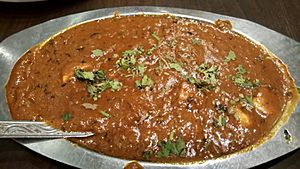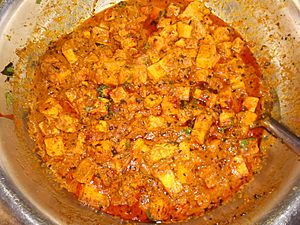Paneer facts for kids
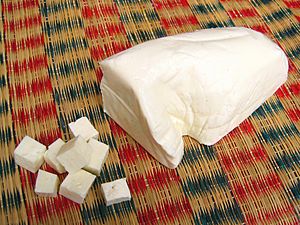
Paneer
|
|
| Alternative names | Poneer, Fonir, Indian cottage cheese |
|---|---|
| Type | Cheese |
| Place of origin | Indian Subcontinent |
| Main ingredients | Strained curdled milk |
| Other information | Rich source of milk protein |
Paneer is a popular type of fresh cheese. It is also called Indian cottage cheese. You can find it in many countries in the Indian subcontinent, like India, Bangladesh, and Nepal. Paneer is usually made from cow or buffalo milk.
This cheese is special because it is non-aged. This means it is eaten fresh and not left to ripen over time. It is also a non-melting soft cheese. Paneer is made by making milk curdle with something sour, like lemon juice or vinegar. The soft, curdled milk before it's pressed into cheese is called chhena.
Contents
What's in a Name?
The word paneer comes from the Persian language. In Persian, the word "panir" means 'cheese'. You can find similar words for cheese in other languages too. For example, in Armenian, Azerbaijani, and Turkish, the words for cheese sound very much like "paneer". This shows how the word traveled across different cultures.
The Story of Paneer
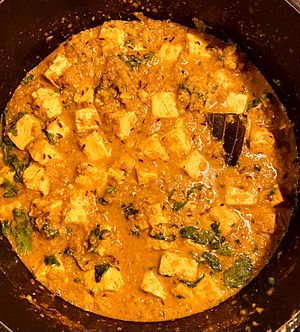
The exact beginning of paneer is a bit of a mystery. Some people think it started in ancient India. Others believe it came from Afghanistan or Iran. There is also a theory that it was introduced by the Portuguese in Bengal.
Some old Indian writings mention a type of milk product. Some experts think this might have been an early form of paneer. However, other historians say that making milk sour was not common in ancient Indian culture. They point out that old stories often talk about milk, butter, and yogurt, but not sour milk cheese.
A popular idea is that paneer became well-known in the Indian subcontinent when Muslim rulers arrived. They might have brought the idea from Persian lands. During the Delhi Sultanate and Mughal Empire periods, paneer likely developed into the cheese we know today.
Another theory suggests that the Portuguese taught people in Bengal how to "break" milk with acid in the 1600s. This method creates cheeses like paneer and chhena. So, some believe that Indian acid-set cheeses first appeared in Bengal because of Portuguese influence.
How Paneer is Made
| Nutritional value per 100 g | |
|---|---|
| Energy | 1,108.76 kJ (265.00 kcal) |
|
1.2 g
|
|
|
20.8 g
|
|
|
Protein
|
18.3 g
|
| Minerals | Quantity
%DV†
|
| Calcium |
21%
208 mg |
| †Percentages estimated using US recommendations for adults. Source: What is the nutritional value of paneer? - Doctor NDTV |
|
Making paneer is quite simple. First, you heat milk until it's hot. Then, you add a food acid like lemon juice, vinegar, or citric acid. This makes the milk separate into solid curds and liquid whey.
Next, the curds are drained using a thin cloth, like muslin or cheesecloth. The extra water is pressed out. To make the paneer even better, it is often dipped in cold water for a few hours. This helps its texture and how it looks.
How paneer is prepared next depends on where it's being made and how it will be used.
- In North India, the curds are wrapped in cloth and pressed under a heavy weight for a few hours. This makes firm blocks that can be cut into cubes for curries. If you press it for a shorter time, about 20 minutes, you get a softer, fluffier cheese.
- In East Indian cooking, like in Bengal, the chhena (curds) are kneaded by hand until they are like dough. Salt is added, and then it's hardened to make ponir. This is often eaten in slices with biscuits or bread. It can also be deep-fried or used in other dishes.
- In the city of Surat in Gujarat, they make surti paneer. This involves draining the curds and letting them ripen in whey for 12 to 36 hours.
Paneer in Delicious Dishes

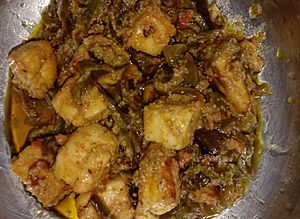
Paneer is the most common type of cheese used in traditional cooking from the Indian subcontinent. It is very versatile! You can find it in many different kinds of meals.
Sometimes, paneer is wrapped in dough and deep-fried. It is often served with vegetables like spinach (palak paneer) or peas (mattar paneer). Paneer can be sweet, like in shahi paneer, or spicy, like in chilli paneer.
A famous sweet dish called rasgulla uses plain chhena. The chhena is beaten by hand and shaped into balls. These balls are then boiled in sweet syrup. The chhena for sweets is made a bit differently. It's drained but not pressed much, so it stays soft and easy to shape.
Popular Paneer Dishes
Here are some well-known dishes that use paneer:
- Paneer pulao (paneer mixed with rice)
- Mattar paneer (paneer with peas in a curry)
- Shahi paneer (paneer cooked in a rich, creamy curry)
- Paneer tikka (paneer pieces put on skewers and roasted, like a vegetarian version of chicken tikka)
- Paneer tikka masala
- Chilli paneer (a spicy dish with paneer, chilies, onions, and bell peppers, often served dry)
- Paneer pakora (paneer pieces dipped in batter and deep-fried)
- Palak paneer (paneer with spinach)
- Khoya paneer
- Paneer momo (dumplings filled with paneer)
- Paneer saganaki
- Paneer butter masala
- Paneer pasanda (stuffed paneer sandwiches in a creamy gravy)
- Paneer lababdar
- Paneer Do Pyaaz (named because it uses two types of onions or onions added at two different stages).
Cheeses Like Paneer
There are other cheeses around the world that are similar to paneer.
- Anari from Cyprus tastes and feels a lot like fresh paneer.
- Circassian cheese is made in a similar way. It's close to paneer in texture but is usually salted.
- Farmer cheese and firm types of quark are also similar. However, they are made from cultured milk and can be salted.
- In the Americas and Spain, Queso blanco or queso fresco are often used as substitutes for paneer. They are easier to find in many markets. Queso blanco is a good match because it's also made by adding acid to milk. Both are usually salted, unlike paneer.
- Paneer is also similar to unsalted halloumi cheese.
See also
 In Spanish: Queso panir para niños
In Spanish: Queso panir para niños



